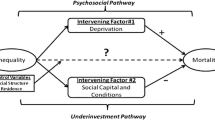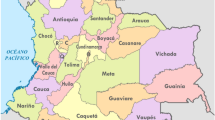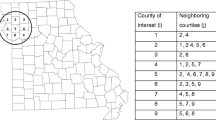Abstract
Urbanization is high and growing in low- and middle-income countries, but intraurban variations in adult health have been infrequently examined. We used spatial analysis methods to investigate spatial variation in total, cardiovascular disease, respiratory disease, and neoplasm adult mortality in Buenos Aires, Argentina, a large city within a middle-income country in Latin America. Conditional autoregressive models were used to examine the contribution of socioeconomic inequalities to the spatial patterning observed. Spatial autocorrelation was present in both men and women for total deaths, cardiovascular deaths, and other causes of death (Moran’s Is ranging from 0.15 to 0.37). There was some spatial autocorrelation for respiratory deaths, which was stronger in men than in women. Neoplasm deaths were not spatially patterned. Socioeconomic disadvantage explained some of this spatial patterning and was strongly associated with death from all causes except respiratory deaths in women and neoplasms in men and women [relative rates (RR) for 90th vs 10th percentile of percent of adults with incomplete high school and 95% confidence intervals: 1.23 and 1.09–1.39 vs 1.24 and 1.08–1.42 for total deaths in men and women, respectively; 1.36 and 1.15–1.60 vs 1.22 and 1.01–1.47 for cardiovascular deaths; 1.21 and 0.97–1.52 vs 1.07 and 0.85–1.34 for respiratory deaths; 0.94 and 0.85–1.04 vs 1.03 and 0.87–1.22 for neoplasms; and 1.49 and 1.20–1.85 vs 1.63 and 1.31–2.03 for other deaths].There is substantial intraurban variation in risk of death within cities. This spatial variability was present for multiple causes of death and is partly explained by the spatial patterning of socioeconomic disadvantage. Our results highlight the pervasive role of space and social inequalities in shaping life and death within large cities.



Similar content being viewed by others
References
Programme UNHS. Challenge of Slums—Global Report on Human Settlements United Nations. New York: United Nations; 2003.
Satterthwaite D. Will most people live in cities? BMJ. 2000;321(7269):1143–1145.
Centre LaCD. Latin America: Urban and rural population projections 1970–2025. Demographic Bulletin. Santiago: United Nations; 2005.
(INDEC) INdEyC. Censo Nacional de Población, Hogares y Viviendas 2001. Vol. 2006. Buenos Aires: Instituto Nacional de Estadística y Censos (INDEC); 2001.
Ezzati M, Vander Hoorn S, Lawes CM, et al. Rethinking the “diseases of affluence” paradigm: global patterns of nutritional risks in relation to economic development. PLoS Med. 2005;2(5):e133.
Hill JO, Wyatt HR, Reed GW, Peters JC. Obesity and the environment: where do we go from here? Science. 2003;299(5608):853–855.
Popkin BM. An overview on the nutrition transition and its health implications: the Bellagio meeting. Public Health Nutr. 2002;5(1A):93–103.
Brunekreef B, Holgate ST. Air pollution and health. Lancet. 2002;360(9341):1233–1242.
Szwarcwald CL, Andrade CL, Bastos FI. Income inequality, residential poverty clustering and infant mortality: a study in Rio de Janeiro, Brazil. Soc Sci Med. 2002;55(12):2083–2092.
de Lima ML, Ximenes RA, de Souza ER, Luna CF, de Albuquerque Mde F. Spatial analysis of socioeconomic determinants of homicide in Brazil. Rev Saude Publica. 2005;39(2):176–182.
Lapa T, Ximenes R, Silva NN, Souza W, Albuquerque M, Campozana G. Leprosy surveillance in Olinda, Brazil, using spatial analysis techniques. Cad Saude Publica. 2001;17(5):1153–1162.
Moran P. Notes on continuous stochastic phenomena. Biometrika 1950;37:17–23.
Waller L, Gotway C. Applied Spatial Statistics for Public Health Data. Hoboken: Wiley; 2004.
Anselin L. Spatial statistical modeling in a GIS environment. In: Maguire D, Batty M, Goodchild M, eds. Spatial Analysis and Modeling. Redlands: ESRI Press; 2005:93–111.
Assuncao RM, Reis EA. A new proposal to adjust Moran’s I for population density. Stat Med. 1999;18(16):2147–2162.
Anselin L. Local indicators of spatial association—LISA. Geogr Anal. 1995;27:93–115.
Bithell JF. A classification of disease mapping methods. Stat Med. 2000;19(17–18):2203–2215.
Marshall R. Mapping disease and mortality rates using empirical Bayes estimators. Appl Stat. 1991;40:283–294.
Anselin L. Rate Transformations. SpaceStat Support Document. Ann Arbor: Terra Seer Inc; 2002.
Rasmussen S. Modelling of discrete spatial variation in epidemiology with SAS using GLIMMIX. Comput Methods Programs Biomed. 2004;76(1):83–89.
Verbeke G, Molenberghs G. Linear Mixed Models for Longitudinal Data. New York: Springer; 2000.
Jerrett M, Eyles J, Cole D. Socioeconomic and environmental covariates of premature mortality in Ontario. Soc Sci Med. 1998;47(1):33–49.
Luginaah I, Jerrett M, Elliott S, Eyles J, Parizeau K, Birch S, Abernathy T, Veenstra G, Hutchinson B, Giovis C. Health profiles of Hamilton: spatial characterisation of neighborhoods for health investigations. GeoJournal. 2001;53:135–147.
`Leyland AH, Langford IH, Rasbash J, Goldstein H. Multivariate spatial models for event data. Stat Med. 2000;19(17–18):2469–2478.
Kaplan GA, Keil JE. Socioeconomic factors and cardiovascular disease: a review of the literature. Circulation. 1993;88(4 Pt 1):1973–1998.
Clayton DG, Bernardinelli L, Montomoli C. Spatial correlation in ecological analysis. Int J Epidemiol. 1993;22(6):1193–1202.
Portes A, Roberts B. La ciudad bajo el libre mercado. In: Portes A, Roberts B, Grimson A, eds. Ciudades latinoamericanas:un analisis comparativo en el umbral del nuevo siglo. Buenos Aires: Prometeo Libros; 2005:19–74.
Cerrutti M, Grimson A. Buenos Aires, neoliberalismo y despues. In: Portes A, Roberts B, Grimson A, eds. Ciudades latinoamericanas:un analisis comparativo en el umbral del nuevo siglo. Buenos Aires: Prometeo; 2005:75–147.
Acknowledgements
This work was supported by RO3 TW007020 from the Fogarty Institute and the National Institutes of Health.
Author information
Authors and Affiliations
Corresponding author
Additional information
Diez Roux and Green Franklin are with the Center for Social Epidemiology and Population Health, Department of Epidemiology, University of Michigan, Ann Arbor, MI, USA; Alazraqui and Spinelli are with the National University of Lanus, Buenos Aires, Argentina.
Rights and permissions
About this article
Cite this article
Diez Roux, A.V., Green Franklin, T., Alazraqui, M. et al. Intraurban Variations in Adult Mortality in a Large Latin American City. J Urban Health 84, 319–333 (2007). https://doi.org/10.1007/s11524-007-9159-5
Published:
Issue Date:
DOI: https://doi.org/10.1007/s11524-007-9159-5




